« December 2009 | Main | February 2010 »
January 31, 2010
Coffee Break

Juliette Binoche, Sara Forestier and Tom Riley in A Few Days in September (Santiago Amigorena - 2006)
Posted by Peter Nellhaus at 12:38 AM
January 28, 2010
Fireball
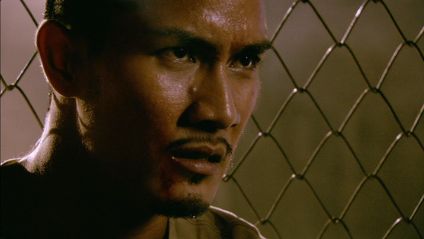
Tarchon, Ta/Chon
Thanakorn Pongsuwan - 2009
Lionsgate Entertainment Region 1 DVD
As if to reinforce what I had written about Thai movies just a couple of days ago, the first Thai movie to get a U.S. DVD release is a genre film, marketed primarily for enthusiasts of films devoted to extreme martial arts. Essentially, the plot involves a man, or group of men, who are put in an arena to fight it out, usually with no rules, until the lone survivor is declared the winner. There may be a sub-plot involving one of the men being put in this situation reluctantly or by force, and having some kind of altruistic motivation for kicking the shit or murdering his opponent(s). That Lionsgate has brought Fireball for DVD for a specific audience was made clear by the trailers for their other releases, two of which had virtually the same plot and cast.
Tai is released from prison under mysterious circumstances when his bail is paid. He finds his twin brother, Tan, in a coma. Tan's girlfriend, Pang, says that Tan attributed his many injuries to a basketball game. Tai goes wandering around under the Bangkok highways to find several pickup basketball games. To make one of the teams, instead of shooting hoops, he has to demonstrate his fighting skill. Making everyone believe he is actually, Tan, Tai becomes involved with an undergound league that plays Fireball, a combination of basketball and muay thai boxing, run by a consortium of gangsters. Tai's goal is to find out who nearly killed his brother, and to make enough money to pay for an expensive operation.

Film critic Roger Garcia, who wrote about Fireball for its presentation at the Udine (Italy) Far East Film Festival last year, thought of the film as a political allegory about present day Thailand. I'm not certain about reading the film that deeply, there is a critique about professional sports. This is made clear in a scene when Den, a team owner, explains the game to a man unfamiliar with the rules of fireball. Two teams of five player compete to either make a basket, or have the last man standing, whichever comes first. Weapons such as knives and steel bars are allowed. While the game itself is designed to attract an audience of rabid fans, the real point of the game is a source of gambling revenue for the team owners. Team players are disposable, while the team owner reap the benefits of games that are sometimes fixed.
Thanakorn's decision to shoot most of the film using hand held cinematography works against the film. In theory, the idea was to give the games a greater sense of immediacy. In execution, there are too many moments when the action is unclear. One of the action scenes that works best is of two players fighting it out in the rain, probably because everything in the shots is highly digitized and sharply defined. Based on this film and his previous Demon Warriors, Thanakorn is at his best when he puts his trust in images that speak for themselves, without the unnecessary hyperventilation of guys chasing after the action with shaky camera work.
Where Fireball really worked best for me was off the court. The scenes of the players personal lives is also an examination of live along the edges of Bangkok. One of the players works selling televisions at a department store, another is a butcher. The butcher is also biracial, part black, allowing for a mention of Thai racism. One of the players is making money to pay rent for his mother, who lives in what is basically a glorified shack located under a highway. He is also hoping to pay for his little brother's education. Another player has an ongoing relationship with a prostitute. Somewhere deep in its heart, Fireball could have been the Thai equivalent to such film noir sports film like Robert Wise's The Set-Up. One of the film's four credited writers is Taweewat Wantha, writer-director of the hilariously anarchic S.A.R.S. Wars, making me wonder if Fireball might have had a more satirical edge in earlier stages of conception. A prequel that explains the origins of fireball during the Viet-Nam war is currently in the works. If Fireball is any indication, than Thanakorn is a filmmaker who needs to learn to explore his ideas and premises with more care, rather than losing the very aspects that would make for an interesting film to a barrage of furious technique.

Posted by Peter Nellhaus at 12:50 AM
January 26, 2010
The Spiritual World

Winyan lok kontai
Tharatap Thewsomboon - 2007
Innoform Media Region 3 DVD
Maybe I'm feeling unnecessarily defensive about some of the choices of films reviewed here, but there are factors to be considered as to why most of the Thai movies I write about are ghost stories. I've learned to enjoy this genre, probably as an outgrowth of living in Thailand for a few months, and watching Thai films that were made primarily for a Thai audience. But also, I am at the mercy of what is available to me as one who has to depend on Thai films with English subtitles. Since around 2006, Thai films have increasingly not had English subtitles on DVDs made for the local market, making some of us dependent on DVDs usually sourced from Malaysia or Hong Kong. Genre films are the most easily exportable to the pan-Asian market, as well as the international market. Recent films by Nonzee Nimibutr and Pen-Ek Ratanaruang are not available as English subtitled DVDs. Wisit Sasanatieng's most recent film was only available as an imported DVD. The only two U.S. based DVD labels that have Thai films with some small degree of consistency are Kino and Strand. A few more films are available through Magnet, primarily thanks to a deal with Tony Jaa's studio. There are Thai films I would love to see, and write about, but can not at this time. But I would hope there are those who have interest in the films I can cover for now.
Ming sees dead people. Not friendly dead people, like the ones Haley Joel Osment saw in The Sixth Sense, but troubled dead people who died violent deaths and have desiccated bodies. Ming's ability to see the dead spirits among the living has become known to those wanted her to communicate with their dearly departed relatives. Ming doesn't know why she has her special ability, only that she finds the dead to be more predictable than the living.

On a superficial level when films are prejudged based on genres and nationalities, The Spiritual World is another Thai ghost story. To enjoy this film may take the affection of this particular genre and its conventions, just as one watches a western or film noir, in part to watch how the film hews to certain elements, and also how the filmmaker chooses to make the film unique, either in the narrative, or with the visual style. The Spiritual World is hyper-styled, with digitized colors and a variety of flashy effects, as well as some snazzy camera work. Within the running time of a bit over an hour and a half, the various visual effects as an asset to the film, adding to the creepiness. There is less gore than is often seen, although based on varied reported running times, it appears that a scene involving an exposed brain that was included in the "making of" supplement was excised from this DVD version.
Ming is sought out by a young doctor, Budd, to find out the circumstances of the death of Budd's father. The story moves into an exploration of childhood trauma and repressed memories. While Ming is able to face most ghosts, it those of her own past that prove most difficult to face. Adding to the emotional toil are the asthma attacks that increase as she gets closer to the truth about the death of Budd's father.
Tharatap creates a visual correlation to the story about the truth revealed in increments. Often times the characters are seen partially visible, with doors, walls, or gates obscuring what the audience sees. The motif adds to the general anxiety because one is never entirely certain about either what is visible, or what is unseen. Certainly Tharatap had some specific expectations made of him regarding the story as the film was from Thailand's biggest studio, Sahamongkol, yet he seems to have been given freedom in the visual aspects to The Spiritual World. There is nothing that I can find in English on Tharatap Thewsomboon, nor is this film even listed with IMDb. Still, The Spiritual World is worth seeing for Tharatap's display of technical bravura, and hopefully an indication of better films to come.

The Spiritual World is available from HK Flix.
Posted by Peter Nellhaus at 12:24 AM
January 24, 2010
Coffee Break

Bernard Campan and Monica Bellucci in How Much do You Love Me? (Bertrand Blier - 2005)
Posted by Peter Nellhaus at 12:38 AM | Comments (5)
January 21, 2010
Rough Cut

Yeong-hwa-neun yeong-hwa-da
Jang Hun - 2008
Ikano Filem All Region DVD
Written and produced by Kim Ki-duk, but directed by Jang Hun, one needs to look a tad closer to see how Rough Cut resembles Kim's other films. There is none of the formalism usually associated with Kim's films. One might suspect that Rough Cut was made as a response to the critical responses regarding what is viewed as Kim's artistic or cultural pretensions, with a film that can be appreciated on a visceral level. What Rough Cut has in common with the films Kim has also directed is his recurring theme about identity.
The climatic fight near the end of Rough Cut is as exhilarating as anything I could imagine. The two main characters are fighting on a muddy beach. From a distance the two look almost the same, covered as they are from head to foot in mud, striking each other with increasingly dissipated strength, until the two men are seen floundering, with one finally staggering away from the scene of battle. I found it impossible not to think of the similar fight in Akira Kurosawa's Stray Dog.

Soo-ta is a popular actor mostly known for his roles in gangster movies. Soo-ta is also known for causing injury to other actors when the action gets too real. A chance meeting with real life gangster Gang-pae, the leader of a small gang, leads to an invitation for Gang-pae to play opposite Soo-ta when no other actor makes himself available. Gang-pae had previous had a small part in a movie. The film follows both the making of Soo-ta's latest crime drama, and collision between the respective characters lives on-screen and off. Rough Cut is as much about the images people think they are projecting to others, as much as the images projected in a movie theater.
In addition to the untitled film in progress, directed by a stocky auteur named Bong (no physical resemblance to the man who made The Host), there is also some footage from Lee Chang-dong's Green Fish, about a young man who joins a criminal gang. At the office of the film producer is a poster for I'm Not There, Todd Haynes' film about public and private identity. The original Korean title is translated as "A Movie is a Movie". The names of the two main characters translate as "star" and "gangster".
Aside from the handful of references to other films, Kim and Jang don't bother with the homages or name checks to be found with Godard or Tarantino. Of more concern is the concept of honesty to oneself and others. Soo-ta insists that his screen fights with Gang-pae be as real as possible, only to find himself discovering that he might not be capable of dealing with that kind of reality. Likewise, Gang-pae learns that creating illusion is physically demanding, comparing himself to a racehorse. One of the funnier moments is when the gangsters observing Gang-pae at work play at being screen actors, hitting each other in slow motion. Rough Cut is also about trust lost and gained, and a movie that, like real life, might not follow the intended script.

Rough Cut is available from HK Flix.
Posted by Peter Nellhaus at 12:02 AM
January 19, 2010
Ghost House

Memory/Memory Rak Lon
Torphong Tankamhaeng - 2008
Innoform Media Region 3 DVD
The original Thai title translates as "Memory Haunted Love". Ghost House is more serious minded than the usual Thai ghost story. On the down side, is the common problem with too many commercial Thai films, of a script that is not as well thought out as it should be, with at least one major plot hole. On the plus side, there are a couple of good jolts. Just when you think Torphong has tipped his hand, the film goes into some unexpected places.
A psychiatrist, Krit, tries to evaluate a young girl, Pare. Pare claims to see a ghost which has physically bruised her. By police order, Krit sees Pare at her home when her mother, Ing-orn, refuses to let her outside of the house. While it helps propel the plot, we see that Krit has questionable standards of professionalism, watching a video of his first interview with Pare at home, with his wife who remarks that the girl would be about the same age as the daughter they would have had. Krit also is shown washing some kind of pill with liquor, when not regularly downing shots at his favorite bar. Discretion is set aside when Krit embarks on an affair with increasingly unstable Ing-orn.

Torphong Tankamhaeng directed the often very funny Seven Days to Leave My Wife. That he's made two very different kinds of films about people with marital problems might raise a question or two. Setting aside whether young Pare has actually seen a ghost, or is transposing a fantasy to mask a more disturbing reality, it is the principle adults in Ghost House who are deeply troubled by their respective pasts from which there is no escape. Ing-orn and Pare have left Bangkok for Chiang Mai in an unsuccessful bid for a quiet, anonymous life. Krit shows compassion for his patients, no matter how dangerous, yet has no feelings for his wife. Ing-orn claims to be protecting her daughter from accusations of being crazy from her ghost sightings, yet the demand for privacy reveals that the mother is hiding some darker secrets.
The build up is slow, but picks up about midway. Krit begins to have have a ghostly sighting of his own, followed by a series of nightmares.
Ghost House is one of several films that Ananda Everingham made during an extremely busy two year stretch between 2007 and 2008. It's only when his back story is discussed that he may have been a few years to young for his role. Mai Charoenpura, a popular Thai star, plays the troubled mother and lover. The age discrepancy is never a topic in the film. Nicely photographed in yellow light, the love scene is not as erotic as intended. Sun Khumpirannon is more than adequate as the girl who insists she is terrorized by a ghost. One major problem with the DVD is that it was formatted in 4:3 ratio, with two shots noticeably squeezed to get both characters within the frame. At a time when DVDs usually have the film's original aspect ratio, or a close approximation, the choice to make Ghost House as a so-called full frame DVD is wrongheaded. What ever weakness there are in Ghost House, it is not without interest as an ambitious attempt to do something different with that staple of Thai cinema, the ghost story.

Ghost House is available from HK Flix.
Posted by Peter Nellhaus at 12:38 AM
January 17, 2010
Coffee Break

Tracey Heggins and Wyatt Cenac in Medicine for Melancholy (Barry Jenkins - 2008)
Posted by Peter Nellhaus at 12:52 AM
January 15, 2010
K-20: Legend of the Mask
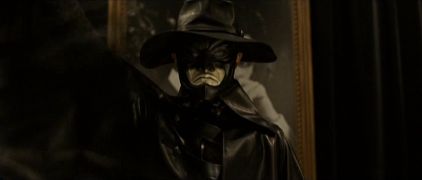
K-20: Kaijin niju menso den
Shimako Sato - 2008
Ikano Filem All Region DVD
In a recently published interview, New York Times film critic Manohla Dargis talks about how Hollywood executives don't believe women can direct action films. The very capable Kathryn Bigelow is considered the exception to the rule for now. Shimako Sato doesn't have the painterly eye of Bigelow, but K-20 is entertaining and affecting. Not that I expect Hollywood to call on Ms. Sato, but she did graduate from the London Film School, and her directorial debut was the British Tale of a Vampire, starring Julian Sands.
The origin of the film began with Edogawa Rampo, but reworked by novelist So Kitamura. The film takes place in a retro-futuristic Japan where World War II did not take place. The class structure of the 19th Century is more firmly entrenched with a group of people of immense wealth, and the working poor who live in shanty towns. At the demonstration of a device that can distribute electricity without wires, K-20 appears to create havoc. The literal translation of the title is "the fiend with twenty faces". When not in disguise, K-20 is dressed in black, and is known for his ability to leap in and out of the action, a combination acrobat and magician. A circus performer known for his skills at illusion, Heikichi Endo, is hired by a mysterious man to photograph the high class detective, Kogoro Akechi, with his fiancee, Yoko Hashiba, from a glass ceiling. Endo is mistaken for K-20 and the adventure begins.
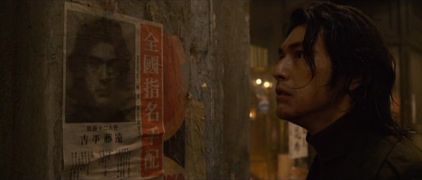
While I liked the general retro-future aspects to the film, like the electrical gizmos that are controlled by giant typewriter keys, Sato's decision to change the time period of the story gnaws at me like some insatiable creature. My main problem is that the change from Rampo's 1930s to an alternative 1949 Japan raises, at least for me, many unanswered questions. The brief English language overview of the character Kogoro Akechi does nothing to explain why Sato would want to distance herself as much as possible from Rampo's novels. Ignoring the questions regarding World War II era Japan, the city of Teito seem more modern than the then contemporary Tokyo of, for example, Akira Kurosawa, with hardly a kimono in sight. There are some visual reminders of Tim Burton's Batman, and Sam Raimi's Spiderman, and the music was no doubt inspired by Danny Elman's work for both filmmakers. With the title character as a master of disguise, I more often thought of Raimi's Darkman, with unlikely, reluctant heroes forced by circumstances to mete out justice outside of the law.
Where Sato really has made the difference is in the character of Yoko. An heiress to a vast fortune created by her industrialist grandfather, Yoko turns out not to be a damsel in distress as she first seems. Yoko is by turns clumsy and naive, but also able to whip out a few karate moves, and most importantly fly a tiny helicopter. Depending on the company she keeps, Yoko is either shy or assertive, both the traditional Japanese young woman and the most modern.
In an interview with Mark Schilling, Sato has indicated the hope to make a sequel. What makes K-20 work is that Sato knows enough to aim her film primarily for a pan-Asian audience, with the casting of Takeshi Kaneshiro, and a story with an appropriate balance of fantasy and reality. K-20 may not be of interest to those who would see English speaking actors in films from the big studios. With a 20 million dollar budget that is a fraction of what's spent on a similar Hollywood film, Sato does well with the resources available. The budget may also explain why the film is heavier on exposition than on set pieces. Those parts of the film devoted to action and special effects are worth the wait. There are more than enough examples of women as on screen action heroes. K-20 adds to the argument that a woman can do just as well handling action behind the camera.
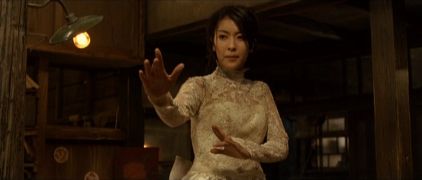
K-20: Legend of the Mask is available from HK Flix.
Posted by Peter Nellhaus at 12:03 AM
January 13, 2010
7 and 7 is

Kimberly Lindbergs of Cinebeats awarded me the "Kreativ Blogger" award. With the questionable spelling, part of me wants to file this in a corner with "Inglorious Basterds". But sometimes these awards serve a purpose of giving other bloggers a bit of encouragement. I'm not sure how if my spending a major chunk of December writing about Hong Kong star Grace Chang could really be considered creative, but I'm not the kind of guy who will chase after the usual end of the year Oscar bait. With as much grace as I can muster, I thank Kimberly for including me in her list of seven bloggers.
Here are the rules you must follow after you receive the Kreativ Blogger award:
1. Thank the person who nominated you for this award.
2. Copy the logo and place it on your blog.
3. Link to the person who nominated you for this award.
4. Name 7 things about yourself that people might find interesting.
5. Nominate 7 Kreativ Bloggers.
6. Post links to the 7 blogs you nominate.
7. Leave a comment on each of the blogs letting them know they have been nominated.
Are there seven things about myself that people might find interesting? I think the operative word here is might.
1. I once got drunk with Nicholas Ray. I was working for no money at the fledgling Northwest Film Study Center in Portland, Oregon, early 1973. Ray was touring the country with 16mm prints of his own movies. I convinced the other staff members that we should show They Live by Night. After the screening, Ray, film students and friends all got together at someone's house for discussion and drinking.
2. Because of my association with the film study center, I was invited to an advanced screening of Deep Throat prior to its Portland premiere. Most of the audience was made up of lawyers. It was explained to me afterwards that if the film was busted, I would be called as an "expert witness" based on my knowledge of film.
3. As a film student at NYU, I helped in the production of one movie with two future Oscar winners. Somewhere in a vault of NYU is this movie, which initially was to be credited to a collective. When I came home after summer vacation, that had changed. Still, it was cool to see my name in the credits.
I also worked on a student movie with future Oscar nominee Martin Brest. I make no apologies for liking Meet Joe Black.
4. As a very gullible seven year old, I was convinced by two neighborhood kids that The Tingler was real.
5. I have a copy of the novel 144 Picadilly autographed by the author, Samuel Fuller.
6. I went to East High School in Denver at the same time as future movie star Pam Grier and future jazz guitarist Bill Frisell.
7. I once made a movie with Toshiro Mifune. Actually it was a Super 8 movie. I filmed him in Dallas in early 1980, if I remember correctly. This was at a regional gathering of Buddhists. Mifune showed off his skill with a sword.
Here are my seven Kreativ Bloggers. I am hoping not to duplicate others and also send this award around the world:
1. Catherine Grant, because she not only takes the time to read all sorts of academic writing on film that's online, but she sorts it out into topics. Also, I'm use to being snowed in for a few days, but Professor Grant wasn't, until recently. She still stayed gracious when I teased her. I indirectly reminded her that the greatest movie ever made was about a boy playing in Colorado snow.
2. gar~, because even if I can't read Japanese, I can still appreciate great screen caps.
3. Sam, because my lack of knowledge of Portuguese doesn't get in the way of reading about Sam's love of Asian films.
4. Quixotando, because until I read about movie pirates, I had never wanted to see a movie by Umberto Lenzi as much as this one.
5. Marilyn Ferdinand because she has made it her mission to save American movies from various forces of destruction.
6. Edward Copeland because he is finding creative ways to stay creative when many of us would probably simply give up.
7. CelineJulie because he somehow sees all sorts of films from all sorts of places, somewhere in Bangkok, and also takes time to cover art and theater. As far as I'm concerned, Jit (his real name), is the true Thailand minister of culture.
Posted by Peter Nellhaus at 12:19 AM | Comments (5)
January 12, 2010
Eric Rohmer: 1920 - 2010
I found out about Eric Rohmer late Monday evening. I just have a couple of personal thoughts. I have a magazine that I bought well over ten years ago, with an issue devoted to black and white photography. Aside from my interest in black and white photography, part of the magazine was devoted to the actresses in Eric Rohmer's film. There was a group shot, that had it been available online, I would have posted. Part of what I liked about Rohmer's films was that the women, aside from generally being attractive (mais oui), always seemed so smart.
The description I once relayed to a friend unfamiliar with Rohmer's films, somewhat jokingly, still stands, and explains my own perhaps misguided identification with several of his films: Eric Rohmer's films are about people who look for love, and in the meantime read a lot of books.
Posted by Peter Nellhaus at 01:17 AM
January 10, 2010
Coffee Break

Ryan O'Neal and Tatum O'Neal in Nickelodeon (Peter Bogdanovich - 1976)
Posted by Peter Nellhaus at 12:47 AM
January 07, 2010
Ichi

Fumihiko Sori - 2008
Funimation Region 1 DVD
Beyond the gimmick of reimagining the venerable blind swordsman as a young woman, Ichi works because, beyond the blindness and the swordplay, the titular character has little resemblance to the source of inspiration. Shintaro Katsu's itinerant masseur was stocky, not handsome, and almost cartoonish when his ears twitched or his nostrils flared at the hint of nearby bad guys. Haruka Ayase's Ichi is much more reserved, playing her character with a consistent seriousness of purpose. Likewise, Fumihiko Sori plays it straight by having the men discuss Ichi's attractiveness, while not exploiting Ayase's beauty, unlike some of the recent manga inspired films with female action heroes.
Just as Zatoichi, as a blind person, was a masseur, one of the professions allowed him, Ichi is a musician, refered to as a goze. Kicked out of the house she was part of for allegedly seducing the husband of the house mistress, Ichi is seeking the man who may know about her father. Traveling with her is Toma, a would-be swordsman, hoping to be a bodyguard. The two come against Banki, a former samurai who now leads an army of bandits who are currently terrorizing a small resort town. The main characters are physically or psychologically damaged, with Toma incapable of drawing his sword after accidentally blinding his mother, and Banki hiding the damaged part of his burnt face, ready to stare down everyone with his one good eye. The story is also about Ichi's mistrust of a world she cannot see.
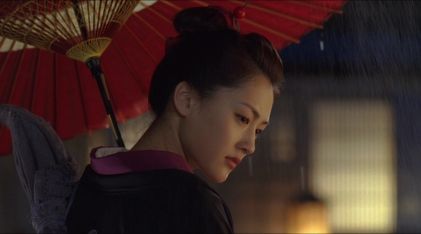
Fumihiko Sori is still a relatively new director, with a career that straddles both live action films and anime. His debut film, Ping Pong won attention and prizes with its story about two high school boys, and their unlikely friendship and rivalry. In ping pong, as in sword fighting, duels are won by skill and endurance. Sori does soup up the action with some hyper editing, but not so much to make the action incomprehensible. The flash backs explain just a little regarding Ichi's past, but may be deliberately vague assuming future sequels are in the works. Where Sori comes closest to anime is with the character of the leering, laughing Banki and his thugs, with their exaggerated faces reminiscent of the highly expressive faces sometimes seen In Japanese scrolls.
Something of a bonus, at least for me, is that the soundtrack was composed by Lisa Gerrard with Michael Edwards. The music will be familiar to anyone who has heard Dead Can Dance or Gerrard's solo albums, as well as her previous film work. Gerrard's music works well with the film, perhaps because Gerrard's vocals convey the constant sadness and sense of isolation of Ichi. It is this seriousness of purpose that makes Ichi a much better film than its premise might suggest. A lesser filmmaker might have gone for burlesque in more than one usage of that word. Even if Ichi turns out to be a one shot rather than a franchise, it is worth seeing for the way Sori and Ayase create a female action hero who does not cater to a juvenile male audience, but instead maintains dignity even in the worse situations.
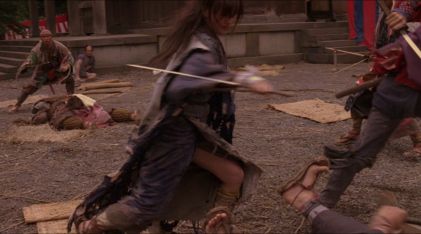
Posted by Peter Nellhaus at 12:11 AM | Comments (1)
January 05, 2010
Onimasa: A Japanese Godfather

Kiryuin Hanako no Shogai
Hideo Gosha - 1982
AnimEigo Region 1 DVD
Early in Onimasa, the young girl who has just be adopted by the neighborhood gangster boss, insists on going to school. Her new father declares that formal education just confuses girls, and instead takes her to a dog fight. The scene of the dog fight sums up the dog-eat-dog viewpoint of Masagoro Kiryuin, also known as Onimasa. That scene also reverberates in a later scene when Onimasa is referred to as the pet dog of a shady businessman who uses yakuza to enforce his will. In the final scene, the barking of the vicious Japanese mastiffs is heard during a duel when Onimasa faces a rival gang. The use of dogs in the film might be obvious, but Gosha keeps any symbolism here from being heavy handed.
The original Japanese title translates as "The Life of Hanako Kiryuin. The film is more about the adopted daughter, Matsue, and her relationship with her adopted family. Even though Tatsuya Nakadai is top billed, to approach this film as primarily being about the character in the internationally used title, or as a genre film, would be a mistake. There are no extended palms, or scenes of gambling, and the one time someone performs the ritual of amputating their pinky is offscreen. Like Gosha's film, The Geisha, Onimasa is based on a novel by Tomiko Miyao. The similarity between the two films, and presumably the novels, is a look at family structures based more on professional relationships, oaths of loyalty, or monetary exchange, and less on biology. The time period for Onimasa runs from 1918 to 1940, with women and children primarily valued as commodities. The concept of people as a form of commodity is also expressed when Onimasa decides to change how his family makes money, with some half-baked ideas for unionization, exploiting superficial understanding between labor and capital, following the request of his boss to curb two union organizers. The two strains of tension are between increasingly outmoded ways of life as Japan becomes more industrialized, and Matsue's torn loyalty between the parents that adopted her, and her own need to assert her independence and intellectual abilities. The original title of the film can be viewed as ironic, as Hanako's death provides the bookends for the main narrative, which is an extended flashback of Matsue's memory of her life with the Kiryuin family.
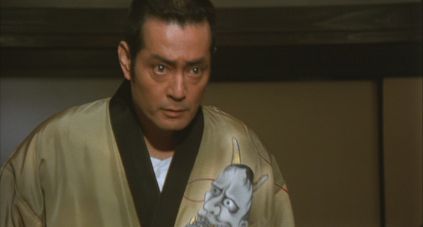
The various narrative threads primarily revolve around Onimasa's relationship with women. His wife, Uta, is the daughter of his boss, Suda. Onimasa has two mistresses that are kept in the house, who formally ask permission of Uta before going to bed with Onimasa. A third mistress, Otsura, is taken as a form of payment from a rival gang leader. Otsura is the mother of Hanaka, a pampered young woman neither as intelligent or as attractive as Matsue. Hanaka also reveals herself to be less filial towards her father than Matsue, in spite of Onimasa's periodic abusive behavior towards his adopted daughter. Onimasa's family makes most of its money through prostitution. A common theme in Gosha's films is how sex is used for barter.
Of the handful of Gosha films I have seen, Onimasa is the least stylized. To some extent, some of the first shots when the young Matsue is introduced to the Kiryuin house and its residents, are filmed from low angles suggesting the point of view of a child. Generally speaking, the use of dramatic camera angles or color is eschewed, with Gosha's more interested in a more straightforward, naturalistic story telling. The unusual sequence would be of Onimasa's wife, Uta remembering the courtship by Onimasa, the dream of a woman fast approaching death from typhus. While the final swordfight between rival yakuza is in itself not unusual, Gosha has the scene take place primarily on a bridge, amidst heavy wind, on a bridge illuminated by two swaying strings of lightbulbs.
Onimasa received a very limited release in the U.S. in 1985. From the New York Times' Vincent Canby: "When it's almost tolerable, Onimasa recalls the the kind of excesses over which Luchino Visconti triumphed in Rocco and His Brothers and 'The Damned, but which defeated him in Ludwig." Lest anyone get the wrong idea, unlike Visconti's films, the men in Gosha's films are all unabashedly heterosexual. As for excesses, Onimasa is quite restrained compared to Goyokin with its references in both style and content to Sergio Leone and Alfred Hitchcock. That there is limited English language material on both Hideo Gosha and Tomiko Miyao is enough to suggest that a more complete understanding of this film by non-Japanese critics is essential.
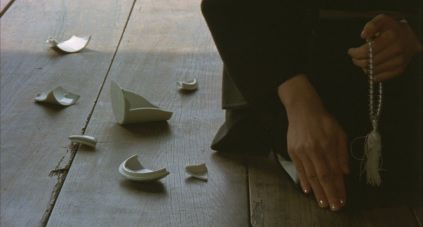
Posted by Peter Nellhaus at 12:25 AM | Comments (1)
January 03, 2010
Coffee Break

Amy Adams in Julie & Julia (Nora Ephron - 2009)
Posted by Peter Nellhaus at 12:36 AM | Comments (1)
January 01, 2010
Happy New Year!

Shin Morikawa in Tora-San, His Tender Love (Azuma Morisaki - 1970)
Posted by Peter Nellhaus at 12:16 AM
